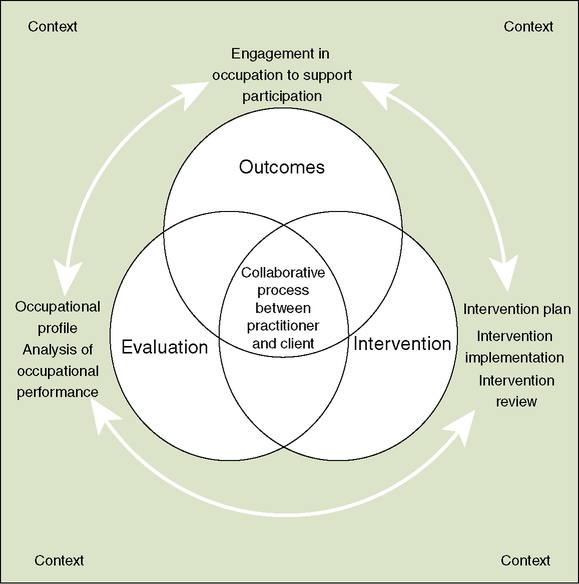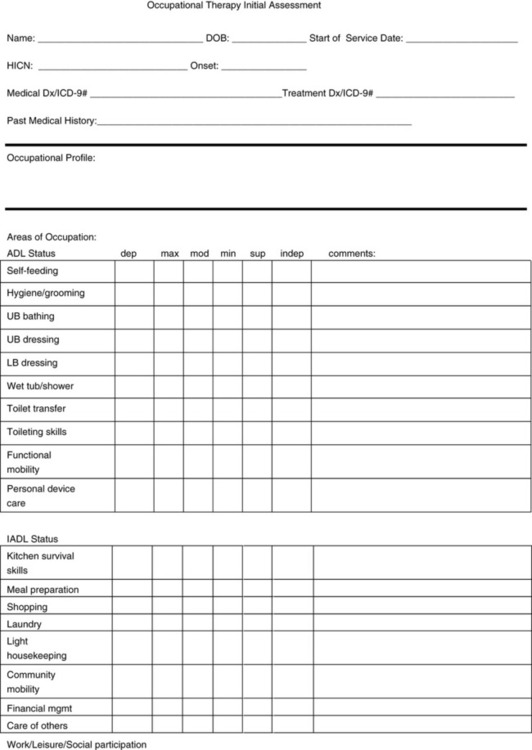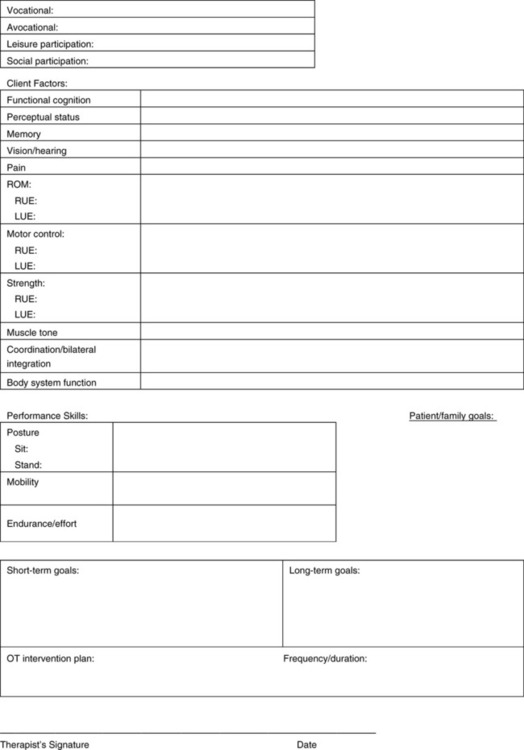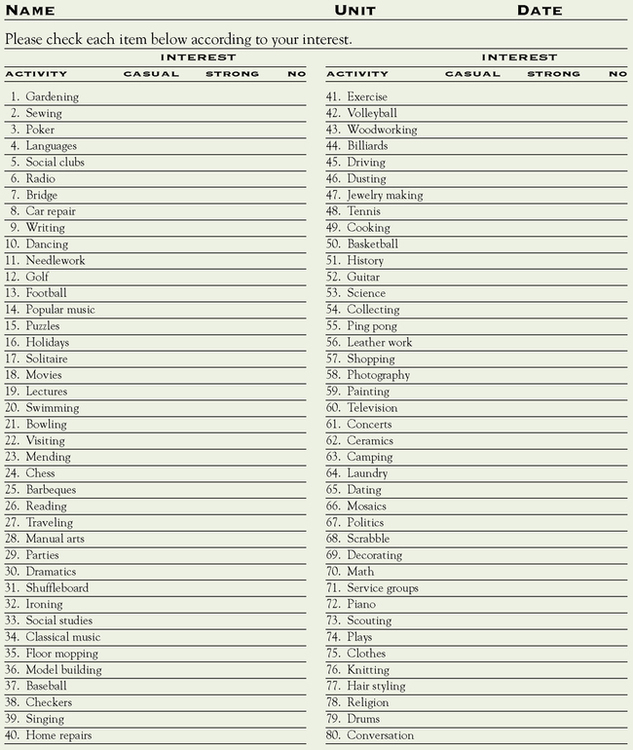After reading this chapter, the reader will be able to do the following: • Describe the occupational therapy referral, screening, and evaluation process • Identify the purpose of the occupational profile • Describe the occupational performance analysis and how it is used in OT • Discuss the steps in conducting an interview • Understand the importance of observation skills in the evaluation process • Identify the steps in the intervention process • Describe the five general intervention approaches used in occupational therapy • Characterize the roles of the occupational therapist (OT) and the occupational therapy assistant (OTA) as they engage in the occupational therapy process The occupational therapy process involves the interaction between the practitioner and the client. The relationship between the practitioner and the client is a collaborative one that involves problem-solving to support the client’s occupational performance. The process is dynamic and the focus is on occupation and the client as an occupational being.2 The client may be an individual, caregiver, group, or population. The occupational therapy process can be divided into the evaluation, intervention, and outcome (Figure 12-1). The evaluation process includes referral, screening, developing an occupational profile, and analyzing occupational performance. The intervention process includes intervention planning, implementation, and review. The outcomes process includes measurement of outcomes and decision-making related to the future direction of intervention (i.e., continue, modify, or discontinue). In this chapter, we describe the components of each stage and delineate the roles of the OT and the OTA throughout the process. The purpose of the evaluation process is to find out what the client wants and needs, and to identify those factors that support or hinder occupational performance.2 The OT practi-tioner develops an occupational profile of the client and analyzes the occupational performance to determine the client’s skills and ability to carry out activities of daily living. The occupational therapy process begins when a referral, a request for service for a particular client, is made.3 The OT is responsible for accepting and responding to the referral. Referrals may come from a physician, another professional, or the client. Referrals may range from a specific prescription for a dynamic orthosis to general suggestions to improve fine-motor problems. Federal, state, and local regulations and the policies of third-party payers determine the type of referral required (e.g., whether a physician’s referral is necessary) and the role an OTA can have in the referral process. Through screening, the OT practitioner gathers preliminary information about the client and determines whether further evaluation and occupational therapy intervention are warranted. Screening typically involves a review of the client’s records, the use of a brief screening test, an interview with the client or caregiver, observation of the client, and/or a discussion of the client with the referral source. The practitioner investigates the client’s prior and current level of occupational performance and determines the client’s future occupational performance needs. The practitioner communicates the screening results to the appropriate individuals, including the party who made the referral.1,3 The OT initiates and directs the screening process, using methods that are appropriate to the client’s developmental level, gender, cultural background, and medical and functional status.1,3 The OTA contributes to the screening process under the direction of an OT. Before screening tasks are performed by an OTA, he or she must achieve service competency in the particular tasks. If screening suggests the client is in need of services, a comprehensive evaluation is arranged. The OT identifies a model of practice (see Chapter 14) from which the evaluation is based. The model of practice helps organize the practitioner’s thinking. From the model of practice, the practitioner selects a frame of reference and chooses assessment instruments consistent with the frame of reference. The goal of this step is to gather information on the client so that an occupational profile can be developed. The OT practitioner obtains initial information about the client, including the client’s age, gender, and reason for referral; diagnosis and medical history (including date of onset); prior living situation and level of function (e.g., independent at home or in a care home); and social, educational, and vocational background. The initial review may provide information regarding precautions that need to be adhered to during the occupational therapy process. This background information is usually recorded in the client’s occupational therapy chart and on the evaluation form. Figure 12-2 illustrates an example of an evaluation form used in an occupational therapy setting. An occupational profile provides the practitioner with a history of the client’s background and functional performance with which to design intervention. The following questions from the Occupational Therapy Practice Framework (OTPF) help the practitioner develop the occupational therapy profile2: • Who is the client (individual, caregiver, group, population)? • Why is the client seeking service? • What are the client’s current concerns relative to engaging in occupations and daily life activities? • What areas of occupation are successful, and what areas are causing problems or risks? • What is the client’s occupational history (i.e., life experiences, values, interests, previous patterns of engagement in occupations and in daily life activities, and the meanings associated with them)? • What are the client’s priorities and desired targeted outcomes? The OT practitioner uses assessments to gather information on a client’s occupational performance in regards to areas, skills, patterns, contexts, client factors, and activity demands (see Chapter 9).2 The results are documented on a form typical to that shown in Figure 12-2. This evaluation information forms the basis for the intervention plan. The interview is the primary mechanism for gathering information for the occupational profile. The interview is a planned and organized way to collect pertinent information. The focus of occupational therapy is occupations, which include the activities in which a person engages throughout the day. Therefore, the practitioner gathers information related to the individual’s occupations. The practitioner asks questions regarding the client’s function in daily activities before the onset of the problem that resulted in the referral. The interview is also used as a means of developing trust and rapport with the client. In some instances, the client is asked to fill out a checklist or questionnaire before the interview. For example, the interest checklist (Figure 12-3) developed by Matsutsuyu8 has served as a model for others. Interest checklists enable clients to report on hobbies and interests. The activity configuration also provides information on how a client spends the day. The client compiles a list of all the different activities in which he or she participates and classifies activities according to the area of performance (e.g., activities of daily living, instrumental activities of daily living, education, work, play, leisure, and social participation). The client rates whether the activity is one he or she has to do or wants to do and how adequately the activity is performed. The practitioner uses the data to determine how the person spends his or her day and in what types of activities he or she is involved.
Occupational Therapy Process
Evaluation, Intervention, and Outcomes

Evaluation Process
Referral
Screening
Occupational Profile
Occupational Performance Analysis
Interview
![]()
Stay updated, free articles. Join our Telegram channel

Full access? Get Clinical Tree


Occupational Therapy Process: Evaluation, Intervention, and Outcomes
Get Clinical Tree app for offline access




